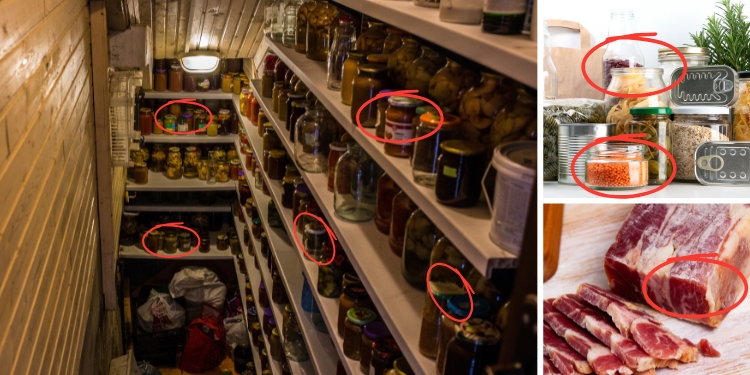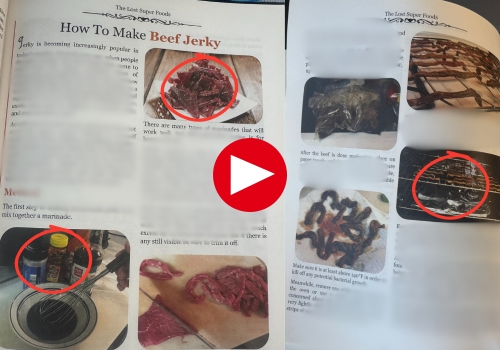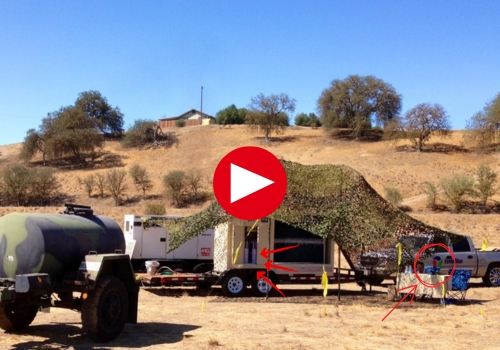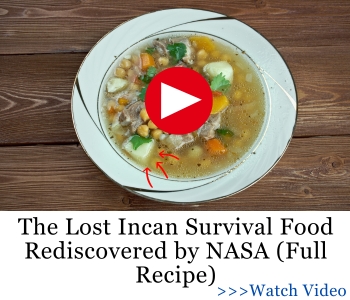Protein is an essential survival fuel when massive supply chain problems, natural disasters, and other SHTF scenarios strike. Protein keeps your muscles strong, your mind sharp, and your immune system ready, and ensures that young people are growing properly.
Stocking shelf-stable sources now, during normal times, can mean the difference between thriving and wasting away when SHTF. The following list of long-lasting protein sources starts with the obvious and edges into the overlooked. You should stockpile from the top of the list, and you can resort to the bottom of the list if SHTF and you’re late getting to the stores.
Canned Tuna
One of the most classic prepper staples, canned tuna is compact, rich in protein and omega-3s. It can remain shelf-stable for up to five years. It’s ready to eat right out of the can, making it a go-to when power or cooking options are limited.
As a weightlifter, I eat a lot of tuna, which makes it easy to keep rotating my stock. While tuna in oil has more calories and lasts longer, tuna in water tends to be more palatable.
Lentils
Dried lentils might not seem flashy, but they’re a secret gem of a protein source. They cook faster than dried beans, don’t require soaking, and pack around 18 grams of protein per cup. They’re also rich in fiber and iron. When sealed in mylar bags with oxygen absorbers, they can last up to 30 years.
Canned Chicken
Fully cooked and pressure-sealed, canned chicken offers convenience with solid protein content. It stores well for years, and you can add it to all kinds of dishes. From soups to wraps to quick skillet dishes, it’s a versatile protein to keep your diet in a disaster from getting too boring.
Powdered Eggs
 A surprising number of people forget that eggs can be stored in powdered form for up to 10 years. They’re a rich source of protein and essential amino acids. Ideally, you want to store them in vacuum-sealed Mylar bags with oxygen absorbers. Each back should be less than 5 pounds.
A surprising number of people forget that eggs can be stored in powdered form for up to 10 years. They’re a rich source of protein and essential amino acids. Ideally, you want to store them in vacuum-sealed Mylar bags with oxygen absorbers. Each back should be less than 5 pounds.
Then, when you want to use them, simply cut open the bag and reconstitute a small portion. This is better than sealing a large quantity, as you can use a small amount without compromising the shelf stability of the remaining bulk powdered egg stockpile.
Peanut Butter
Peanut butter is dense, high in protein, calories, and healthy fats. It’s also a common comfort food that you can use to refuel quickly. Unopened jars can last up to two years — or longer. However, powdered peanut butter, when properly stored, can last up to 10 years.
Dried Beans
Dried pinto, navy, and black beans are inexpensive, compact, and powerfully nutritious. With proper storage, they can last over a decade. A single cooked cup provides up to 15 grams of protein. They’re a good way to add protein and bulk to your meals when meat is scarce.
Canned Salmon
Canned salmon has a similar protein and omega value to tuna, but with higher bioavailable levels of calcium. It gets a little bit of a bad rap, as you’ll often find a few bones. Yet they’re soft enough to eat and actually boost the canned salmon’s survival value!
Jerky
Jerky can be made from beef, turkey, wild game, and other lean meats to provide long-lasting protein. It’s lightweight, flavorful, and portable, making it easy to fit into any stockpile. Most commercially produced jerky lasts 1 to 2 years, but vacuum-sealed, nitrate-treated versions can go longer.
You can make your own beef jerky at home, and this option is becoming increasingly popular among preppers. Store-bought versions can be effective in survival situations, mainly due to their high protein content, but the homemade alternative is much healthier. Here are the ingredients you need for an efficient beef jerky recipe:
- Lean beef (top round, bottom round, sirloin tip, flank steak, or brisket)
- Soy sauce
- Worcestershire sauce
- Liquid smoke (optional, for smoky flavor)
- Salt (or curing salt for longer preservation)
- Black pepper
- Garlic powder
- Onion powder
- Brown sugar or honey (optional, for sweetness)
- Red pepper flakes or cayenne (optional, for heat)
You can find all the details and step-by-step instructions, with pictures, for producing generous amounts of jerky in The Lost SuperFoods. Inside, there are over 125 proven survival recipes, including the famous Doomsday Ration, homemade SPAM, and bark bread.
🍛 Get the physical book here at a special promotional price!
Textured Vegetable Protein
A hallmark protein source for vegans, TVP is a soy-based meat alternative that comes dehydrated and can last up to 20 years when properly packed. You rehydrate it easily with hot water.
It mimics ground meat in texture and protein content, with around 12g per half-cup. It can also take on some of the surrounding flavors. So, you could add it to a soup or casserole that’s low on natural meat as a way to boost the protein value.
Powdered Milk
Powdered milk is shelf-stable for up to a decade or more. It’s also rich in protein, calcium, and vitamin D. Surprisingly versatile, powdered can be used for drinking, baking, or as a sauce base. It’s a great way to add flavor and protein to otherwise bland survival recipes.
Freeze-Dried Meats
Freeze-dried meats are an admittedly expensive protein source. Yet they are long-lasting and retain much of their original nutritional value. Freeze-dried meats are lightweight, and when sealed properly, can keep for up to 25 years.
Chia Seeds
Tiny but mighty, chia seeds are a complete protein source with added fiber and omega-3s. Stored dry in a cool, dark space, they can last up to four years. When soaked, chia seeds expand, which can add some belly-filling bulk to sparse meals.
Dr. Nicole Apelian is a survivor in the truest sense of the word. Diagnosed with MS, she has managed to overcome every obstacle and live as normal a life as possible using health protocols based on natural resources.
A lesser-known fact about Dr. Apelian is that she loves chia seeds and includes them in many of her recipes, including the remedies featured in The Forgotten Home Apothecary.
Quinoa
Unlike most grains, quinoa is a complete protein with all nine essential amino acids. It can last two to three years in a pantry, or up to 10 years when properly sealed in mylar bags with oxygen absorbers. You can even grind quinoa into flour, mix with egg and salt to make gluten-free pasta.
Canned Beans in Brine
Canned beans are a great grab-and-go food that can last up to three years. While heavier than dried beans, they require no prep and are a great way to add a little protein to carb-heavy dishes. You can even use the brine in the can to thicken and add body to soups and sauces.
Shelf-Stable Tofu
Found in aseptic packages, shelf-stable tofu has a surprisingly long shelf life of up to a year or more. It’s a good source of plant-based protein for vegetarians and flexitarians, that can also add some protein to your stockpile.
Dry Split Peas
High in protein and rich in flavor, dry split peas store well and cook fast. They’re perfect for hearty soups or stews and last up to 25 years if packed right. You can use them as the primary body for split pea and ham soups as well as British-style mushy peas. Both of which are satisfying belly fillers.
Canned Sardines
While canned sardines are often thought of as a primary ingredient of college dorm life, these little fish come packed with protein, omega-3s, and calcium. They can easily last three to five years, and the small size of the cans makes them great for compact storage. My buddy always keeps a few in his pack for overnight hunting and fishing trips.
Freeze-Dried Edamame
Edamame retains the full protein profile of soybeans and is surprisingly flavorful. Freeze-dried edamame can keep for up to 10 years but usually costs a bit more when it’s commercially packed. You can also vacuum seal or can fresh edamame for three to four years.
Tree Nuts
Popular tree nuts like almonds, walnuts, and cashews are packed with protein and healthy fats. Most have a shorter shelf life (1–2 years), but vacuum sealing or freezing can extend that. They’re also compact and calorie-dense, making them easy to add to a wide range of foods. I like to grind frozen tree nuts into flour and then add them to baked goods to boost the protein content.
Protein Bars
 Designed for shelf stability and portability, protein bars are a handy option that belongs in any survival stockpile. However, there are a lot of brands that make deceiving marketing promises. Ideally, you want to look for ones with minimal sugar content and long expiration dates. Most of these can last over a year, perhaps two years in cold storage.
Designed for shelf stability and portability, protein bars are a handy option that belongs in any survival stockpile. However, there are a lot of brands that make deceiving marketing promises. Ideally, you want to look for ones with minimal sugar content and long expiration dates. Most of these can last over a year, perhaps two years in cold storage.
I was pleasantly surprised to find a very interesting recipe for protein bars on a budget in A Navy SEAL’s Bug-In Guide. When I bought the book, I expected Joel Lambert to focus more on home security. That’s what both the cover and the author’s Navy SEAL background seemed to suggest.
However, I discovered dozens of long-lasting recipes inside, including protein-rich options, as well as highly effective methods for safely preserving food during crisis times.
Get A Navy SEAL’s Bug-In Guide
Seitan
Seitan is made from vital wheat gluten to create a dense, chewy meat alternative that’s loaded with protein. It’s increasingly popular in vegan-friendly restaurants in Europe and the Middle East, but you can usually find it in the natural foods section of a US grocery store.
Seitan has 21 grams per 3-ounce serving. It also has the shelf-stability of the dry gluten flour itself, which can last over a decade when stored in airtight mylar bags with oxygen absorbers. You just add water and seasonings to form and cook it.
Hard Cheese In a Wheel
Hard cheeses sealed in wax or freeze-dried can last months to years without refrigeration. Waxed cheddar is a traditional form of food preservation still viable today. If you can source it in the US, an untouched wheel of Parmesan or Grana Padana is also a viable long-term storage alternative.
On a side note, dairy is central to Amish life. Many Amish families produce their own milk, butter, and cheese. Waxed cheeses are still commonly made and stored for months without refrigeration. You can learn everything about the Amish techniques and food storage secrets right here.
Sunflower Seeds
With a good protein-to-weight ratio and healthy fats, sunflower seeds make an easy snack or add-in. When frozen and kept sealed and dry, they’ll last 12 to 18 months.
Homemade Dehydrated Eggs or Meats
You can make your own dehydrated foods, which can last for years when stored with oxygen absorbers in mylar bags. Dehydrating lets you preserve your own protein sources off-grid. It’s a great way to make use of lean cuts of meat and excess wild game. Most quality food dehydrators pay for themselves after just a few uses.
Crickets or Acheta Protein Powder
While it might sound a little gross at first, crickets are about 60% protein by weight. You can raise them yourself or by commercially processing insect protein powder. It’s shelf-stable and nutrient-rich. It’s already a survival staple in many parts of the world. I’ve even seen bags of Acheta in baking and ethnic foods aisles of major US stores.
One More Thing That You Need
Protein is crucial for the human body. It gives you physical strength, endurance, and the ability to think clearly. These things are essential, especially in times of crisis. Another thing that must be secured is water.
Clean water and nutritious food are your pillars of survival in any scenario. If you have protein-rich food, you’ll also need clean water for hydration and for preparing your meals.
The problem is you can’t rely on the public water supply, as it’s very likely to fail during a crisis. In fact, even under normal conditions, tap water isn’t always safe…
That’s why you need a reliable backup that gives you peace of mind knowing you won’t run out of water. I, along with 40,000 other Americans, chose the solution developed and tested by U.S. Army specialists.
To provide water for soldiers on the toughest battlefields in the world, our military uses The Water Freedom System. Although it sounds complex, it’s actually a device you can build yourself at home. Simple, fast, and affordable!
The military-grade plans are now available to the general public, and you can download them from here and get to work. You’ll have, without complications, a safe long-term system that only needs air and a power source to generate all the clean water you’ll ever need. Anytime, anywhere.
Final Thoughts on Long-Lasting Protein Sources
Protein is essential for maintaining your strength and resilience during challenging times. If you’re building a stockpile from scratch, be sure to include a few options from the top of this list. If a disaster is about to strike and you’re running late to the stores, you might have better luck looking for items toward the bottom of this list that other people might walk right past.
To keep your stored protein sources safe, you need a well-built root cellar. I recommend another inexpensive project that you can build on your own. It costs less than replacing a flat-screen TV, and it can also serve as an underground bunker in case of an EMP or nuclear attack. Check out The Easy Cellar.
You may also like:
8 Cheap Protein Sources to Add to Your Stockpile Right Now
You Can Have This Portable Water Generator Up And Running By The End Of The Day (Video)

























Great article! We shouldn’t ignore important protein sources for long-term health.
Absolutely! Protein isn’t just about calories—it’s what keeps muscle from wasting away in long-term crises. A lot of folks think only about bulk calories (rice, beans, pasta), but protein is what helps you stay strong enough to actually use that energy.
Great article! Just like quality protein sources support long-term health, keeping our surroundings clean is equally important.
That’s a great point—disease will take people out faster than hunger. Stockpiling food is step one, but keeping a clean camp or home base means you can actually live long enough to eat it. Hygiene is survival.
Not to forget canned deviled ham and chicken, and canned Vienna sausage. Not as tasty as they used to be, they store for 3 years in cheap, light weight cans that are easy to carry and require no prep. Protein and calories.
Yes! Those little cans are overlooked, but they’re lightweight, compact, and packed with protein and fat.
What I really learned from this article, is I have been doing it right. Sure I have an assortment of prepper foodstuff meals, but my canned goods that I buy and rotate regularly are mostly a list of those things mentioned above. My dried goods too are mentioned in the article, and while I do buy freeze dried items … the bulk of which are listed in the article as well. So I am kind of patting myself on the back (without wrenching my joints out of place). Living in the desert though … the biggest issue is water. I have 110 gallons in two barrels, and over 230 gallons in rain barrels, as well as some canned water … but I am well aware that is not enough … and am trying to resource more.
Sounds like you’re ahead of the curve. The desert makes water the real currency of survival. Having over 300 gallons already puts you miles beyond most people.
Great Article
always remember : RISK in Canned Foods
Selmanila, botchelism
Dried is beater but Mold and moisture is problem
Rotation , Dated, reviews
Never Know
So many Lost , uneducated , Indrocinated
Pray, Fast , keep God at the forefront of your life
So when it happens , You understand the true heart of mankind Did it
NOT God , God always Saves, Restores, Builds, and is Good
Very true—every storage method has its risks. That’s why rotation and inspection are key. Canned, dried, or freeze-dried—none of it lasts forever. And yes, faith and preparedness go hand in hand.
Perfect information to all , God sent!
Glad it hit home for you. Sometimes the right reminder comes at the right time.
I learned, almost the hard way, that the “pop top” canned goods don’t keep as long as traditional cans. To make the pop top, the manufacturer has to make the metal extremely thin so it will open. Depending on what is inside, the metal can degrade some and leak.
One can gone isn’t a disaster, but it surely makes a mess!
Good lesson to pass along. Those pop tops are convenient now but a liability in long-term storage. Traditional cans with a can opener are still king for preppers.
In my journey as a prepper here lately i started focusing on what I am eating right now and how i can incorporate that food into shtf scenarios . Even getting old may give me a extra few years of a quality life to figure things out .It made me happy to find out that a 1 lb bag of dry split peas…13 servings….1/4 cup [ 35g ] per serving….has 8g of protein….9 g of fiber…cook’s up in simmering water about 20 minutes.Plus its green….Trust me i have no love for the taste but mix in some corn and ham..ketchup….salt…tastes great. i noticed on the tv show Alone …what you eat is key….even if you have shelter…..fire….water…..in the long term . I am starting to sound like my grandmother ….
Exactly—you nailed it. Survival is about more than fire and shelter. Long-term, food variety and nutrition are what keep you thinking straight and moving forward. Split peas aren’t glamorous, but they’re a powerhouse survival food.
It might be interesting to see what NASA is coming up with what the astronaut’s will be eating on their flights to Mars that coming up soon…..the future Lewis and Clark’s
Great thought… NASA’s research has given us a lot of ideas in food preservation and nutrition. Some of today’s freeze-dried meals came straight out of space programs. We might all end up eating like astronauts someday.
Orion,
The answer to your water problem is right here within the text of this article. You can get anywhere from 40 to 60 gallons of fresh, clean potable water per day by building and utilizing the home-built device in the video. Download the plans from the article and for a couple of hundred $ (or you may possibly have a lot of the components on hand) start acquiring what is needed to build your own water source. You’re only problem then is to figure out where and how you’re going to store all of the water. 🙂
I live in the southern Willamette Valley of Oregon with a 365′ deep well that no longer produces water and we have to buy water bi-monthly 2,500 gallons for $120 per delivery. When we plant our veggies for the year, that water is delivered 4-5 times a month. Lots of $$$$$$. This device will help me eliminate that cost from my monthly expenses. Stay alert and keep on prepping. It sounds like you’re doing everything right.
That’s a solid tip. Water independence is priceless, especially when hauling or buying water becomes unsustainable. Having your own system gives you true peace of mind—and you’re right, storage then becomes the next challenge.
BEANS BEANS BEANS Beans always need a grain mixed with them, rice, corn, wheat, etc, to be a COMPLETE protein. This seems to be overlooked